Analysis of Obesity in Australia: Challenges, Factors, and Solutions
VerifiedAdded on 2021/09/17
|7
|1660
|65
Essay
AI Summary
This essay provides an in-depth analysis of obesity in Australia, examining its prevalence, challenges, and contributing factors. It highlights statistical data and identifies the increasing economic burden associated with obesity. The essay delves into the biomedical and socio-economical models, outlining biological, social, cultural, and economic factors that influence obesity. It further explores various countermeasures, including government initiatives, policy interventions, and proposed strategies such as healthy eating and active living programs, junk food taxation, and social media campaigns. The conclusion emphasizes the need for increased awareness, government collaboration, and skilled practitioners to reduce obesity and promote healthier lifestyles. References to relevant studies and reports are included to support the arguments presented.
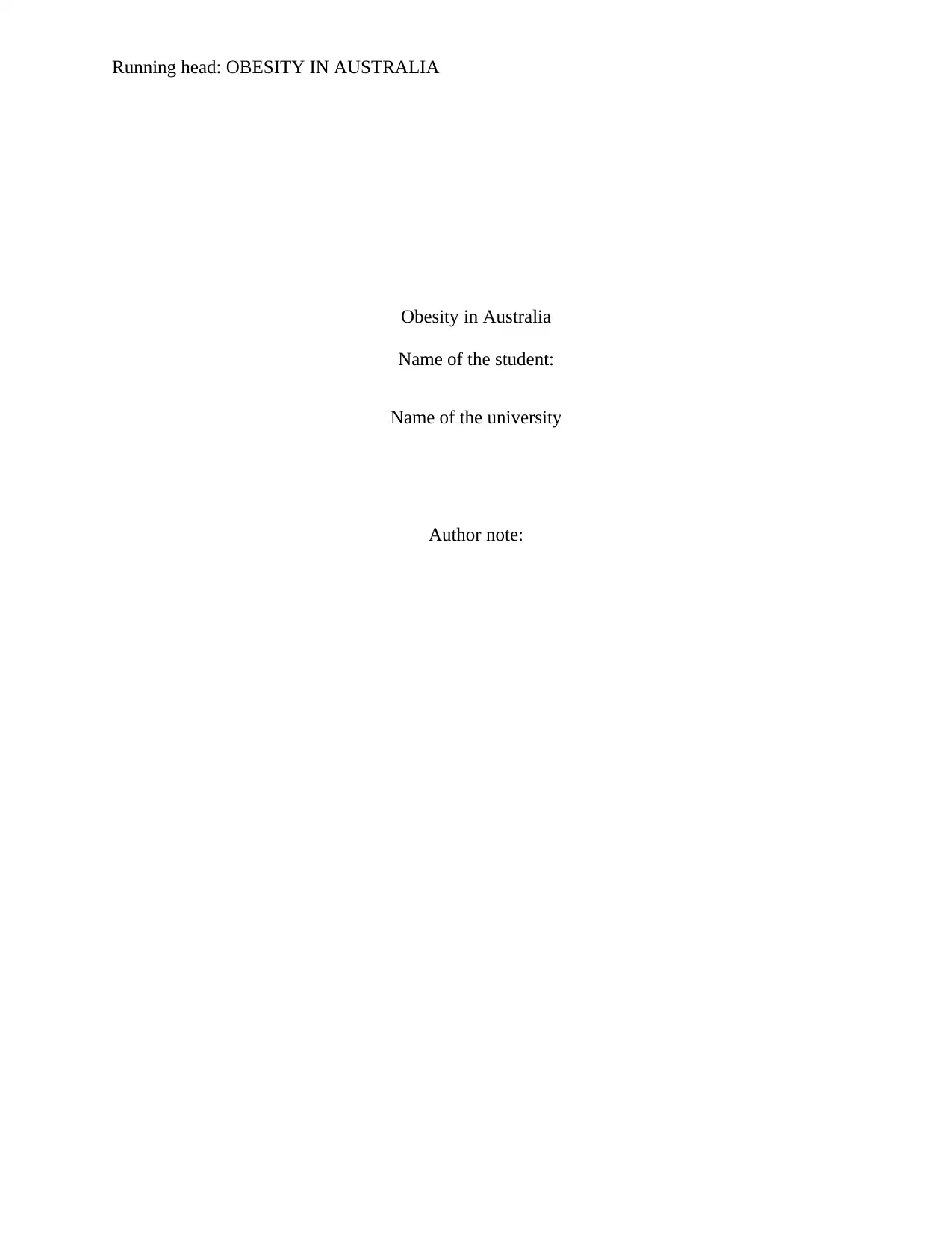
Running head: OBESITY IN AUSTRALIA
Obesity in Australia
Name of the student:
Name of the university
Author note:
Obesity in Australia
Name of the student:
Name of the university
Author note:
Paraphrase This Document
Need a fresh take? Get an instant paraphrase of this document with our AI Paraphraser
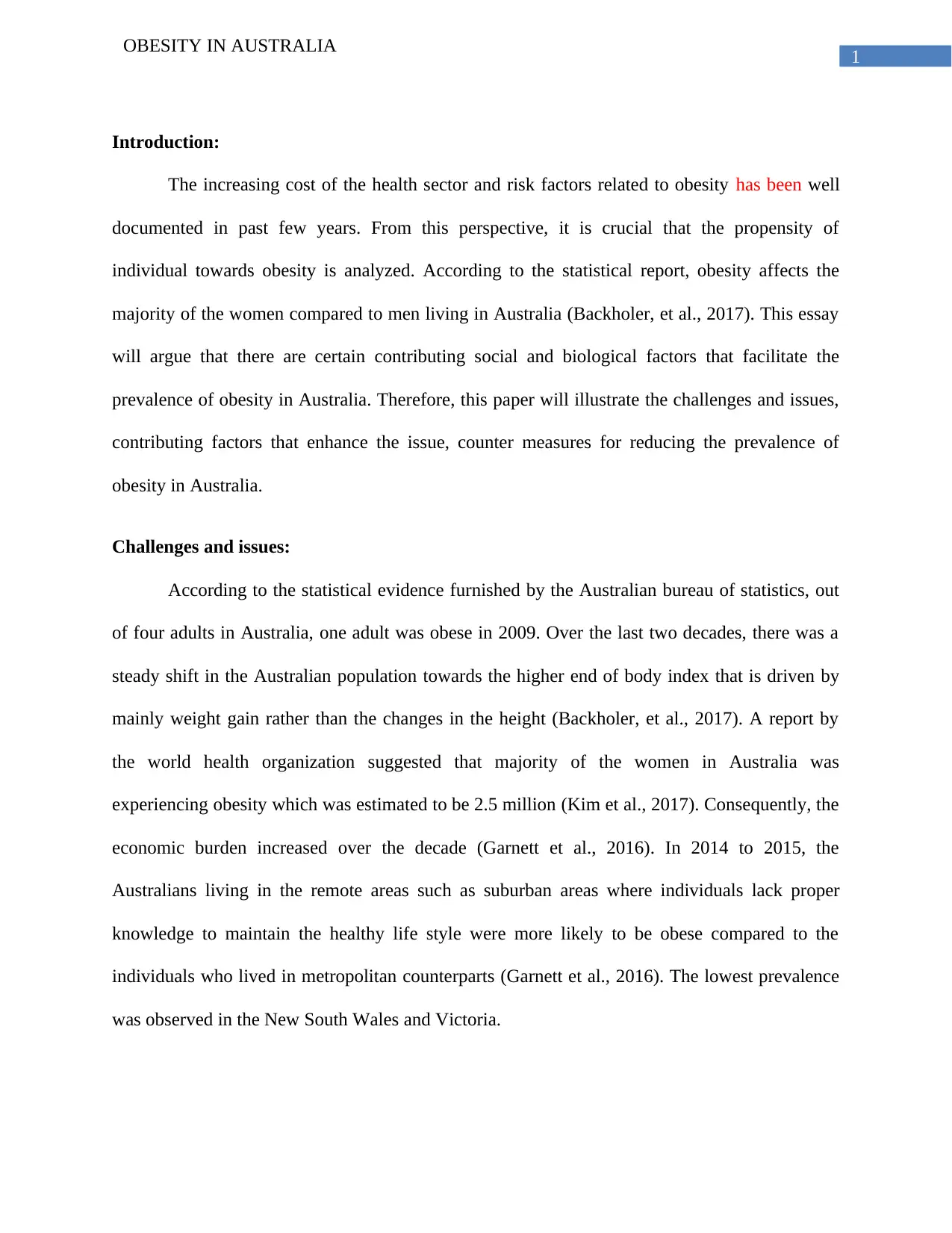
1
OBESITY IN AUSTRALIA
Introduction:
The increasing cost of the health sector and risk factors related to obesity has been well
documented in past few years. From this perspective, it is crucial that the propensity of
individual towards obesity is analyzed. According to the statistical report, obesity affects the
majority of the women compared to men living in Australia (Backholer, et al., 2017). This essay
will argue that there are certain contributing social and biological factors that facilitate the
prevalence of obesity in Australia. Therefore, this paper will illustrate the challenges and issues,
contributing factors that enhance the issue, counter measures for reducing the prevalence of
obesity in Australia.
Challenges and issues:
According to the statistical evidence furnished by the Australian bureau of statistics, out
of four adults in Australia, one adult was obese in 2009. Over the last two decades, there was a
steady shift in the Australian population towards the higher end of body index that is driven by
mainly weight gain rather than the changes in the height (Backholer, et al., 2017). A report by
the world health organization suggested that majority of the women in Australia was
experiencing obesity which was estimated to be 2.5 million (Kim et al., 2017). Consequently, the
economic burden increased over the decade (Garnett et al., 2016). In 2014 to 2015, the
Australians living in the remote areas such as suburban areas where individuals lack proper
knowledge to maintain the healthy life style were more likely to be obese compared to the
individuals who lived in metropolitan counterparts (Garnett et al., 2016). The lowest prevalence
was observed in the New South Wales and Victoria.
OBESITY IN AUSTRALIA
Introduction:
The increasing cost of the health sector and risk factors related to obesity has been well
documented in past few years. From this perspective, it is crucial that the propensity of
individual towards obesity is analyzed. According to the statistical report, obesity affects the
majority of the women compared to men living in Australia (Backholer, et al., 2017). This essay
will argue that there are certain contributing social and biological factors that facilitate the
prevalence of obesity in Australia. Therefore, this paper will illustrate the challenges and issues,
contributing factors that enhance the issue, counter measures for reducing the prevalence of
obesity in Australia.
Challenges and issues:
According to the statistical evidence furnished by the Australian bureau of statistics, out
of four adults in Australia, one adult was obese in 2009. Over the last two decades, there was a
steady shift in the Australian population towards the higher end of body index that is driven by
mainly weight gain rather than the changes in the height (Backholer, et al., 2017). A report by
the world health organization suggested that majority of the women in Australia was
experiencing obesity which was estimated to be 2.5 million (Kim et al., 2017). Consequently, the
economic burden increased over the decade (Garnett et al., 2016). In 2014 to 2015, the
Australians living in the remote areas such as suburban areas where individuals lack proper
knowledge to maintain the healthy life style were more likely to be obese compared to the
individuals who lived in metropolitan counterparts (Garnett et al., 2016). The lowest prevalence
was observed in the New South Wales and Victoria.
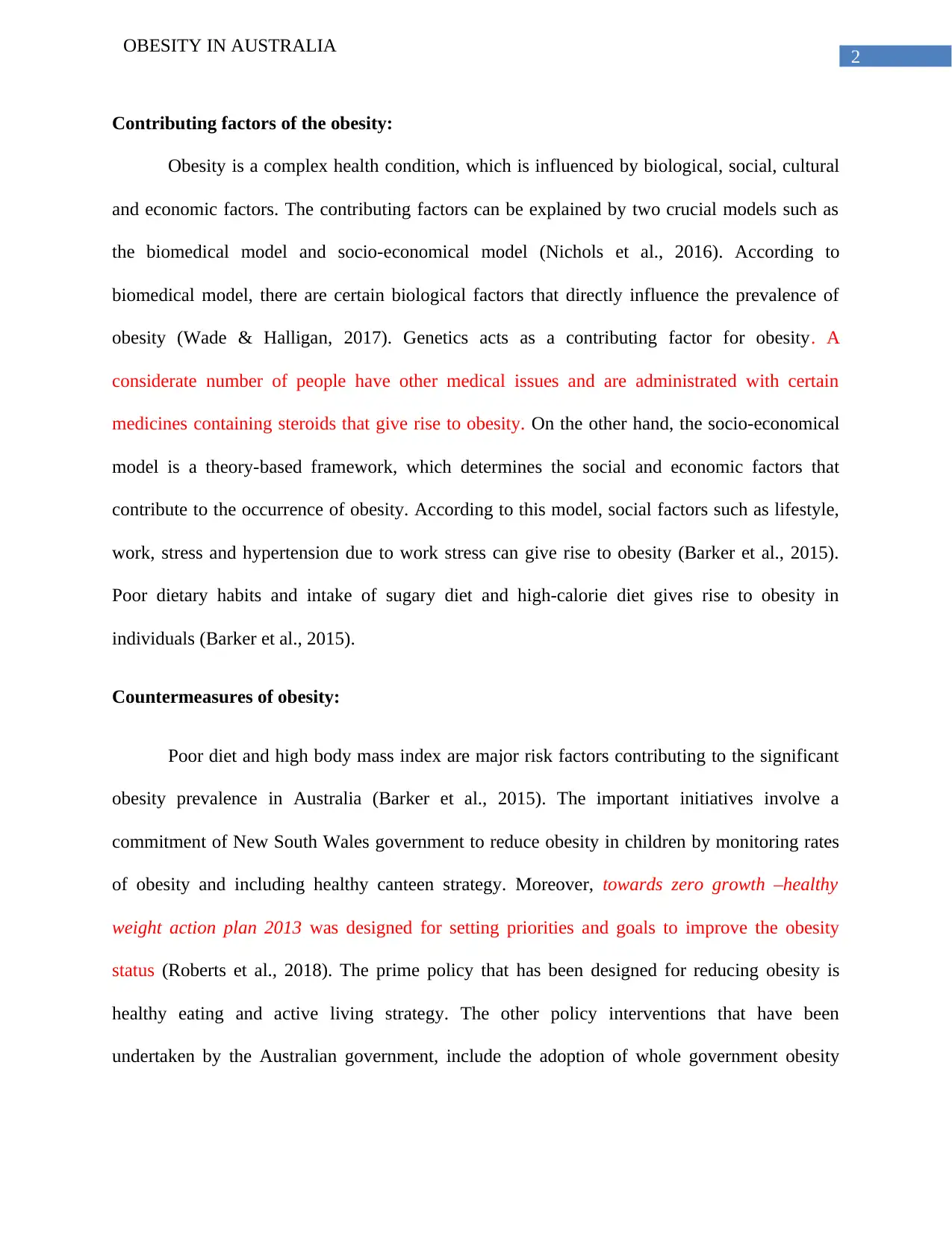
2
OBESITY IN AUSTRALIA
Contributing factors of the obesity:
Obesity is a complex health condition, which is influenced by biological, social, cultural
and economic factors. The contributing factors can be explained by two crucial models such as
the biomedical model and socio-economical model (Nichols et al., 2016). According to
biomedical model, there are certain biological factors that directly influence the prevalence of
obesity (Wade & Halligan, 2017). Genetics acts as a contributing factor for obesity. A
considerate number of people have other medical issues and are administrated with certain
medicines containing steroids that give rise to obesity. On the other hand, the socio-economical
model is a theory-based framework, which determines the social and economic factors that
contribute to the occurrence of obesity. According to this model, social factors such as lifestyle,
work, stress and hypertension due to work stress can give rise to obesity (Barker et al., 2015).
Poor dietary habits and intake of sugary diet and high-calorie diet gives rise to obesity in
individuals (Barker et al., 2015).
Countermeasures of obesity:
Poor diet and high body mass index are major risk factors contributing to the significant
obesity prevalence in Australia (Barker et al., 2015). The important initiatives involve a
commitment of New South Wales government to reduce obesity in children by monitoring rates
of obesity and including healthy canteen strategy. Moreover, towards zero growth –healthy
weight action plan 2013 was designed for setting priorities and goals to improve the obesity
status (Roberts et al., 2018). The prime policy that has been designed for reducing obesity is
healthy eating and active living strategy. The other policy interventions that have been
undertaken by the Australian government, include the adoption of whole government obesity
OBESITY IN AUSTRALIA
Contributing factors of the obesity:
Obesity is a complex health condition, which is influenced by biological, social, cultural
and economic factors. The contributing factors can be explained by two crucial models such as
the biomedical model and socio-economical model (Nichols et al., 2016). According to
biomedical model, there are certain biological factors that directly influence the prevalence of
obesity (Wade & Halligan, 2017). Genetics acts as a contributing factor for obesity. A
considerate number of people have other medical issues and are administrated with certain
medicines containing steroids that give rise to obesity. On the other hand, the socio-economical
model is a theory-based framework, which determines the social and economic factors that
contribute to the occurrence of obesity. According to this model, social factors such as lifestyle,
work, stress and hypertension due to work stress can give rise to obesity (Barker et al., 2015).
Poor dietary habits and intake of sugary diet and high-calorie diet gives rise to obesity in
individuals (Barker et al., 2015).
Countermeasures of obesity:
Poor diet and high body mass index are major risk factors contributing to the significant
obesity prevalence in Australia (Barker et al., 2015). The important initiatives involve a
commitment of New South Wales government to reduce obesity in children by monitoring rates
of obesity and including healthy canteen strategy. Moreover, towards zero growth –healthy
weight action plan 2013 was designed for setting priorities and goals to improve the obesity
status (Roberts et al., 2018). The prime policy that has been designed for reducing obesity is
healthy eating and active living strategy. The other policy interventions that have been
undertaken by the Australian government, include the adoption of whole government obesity
⊘ This is a preview!⊘
Do you want full access?
Subscribe today to unlock all pages.

Trusted by 1+ million students worldwide
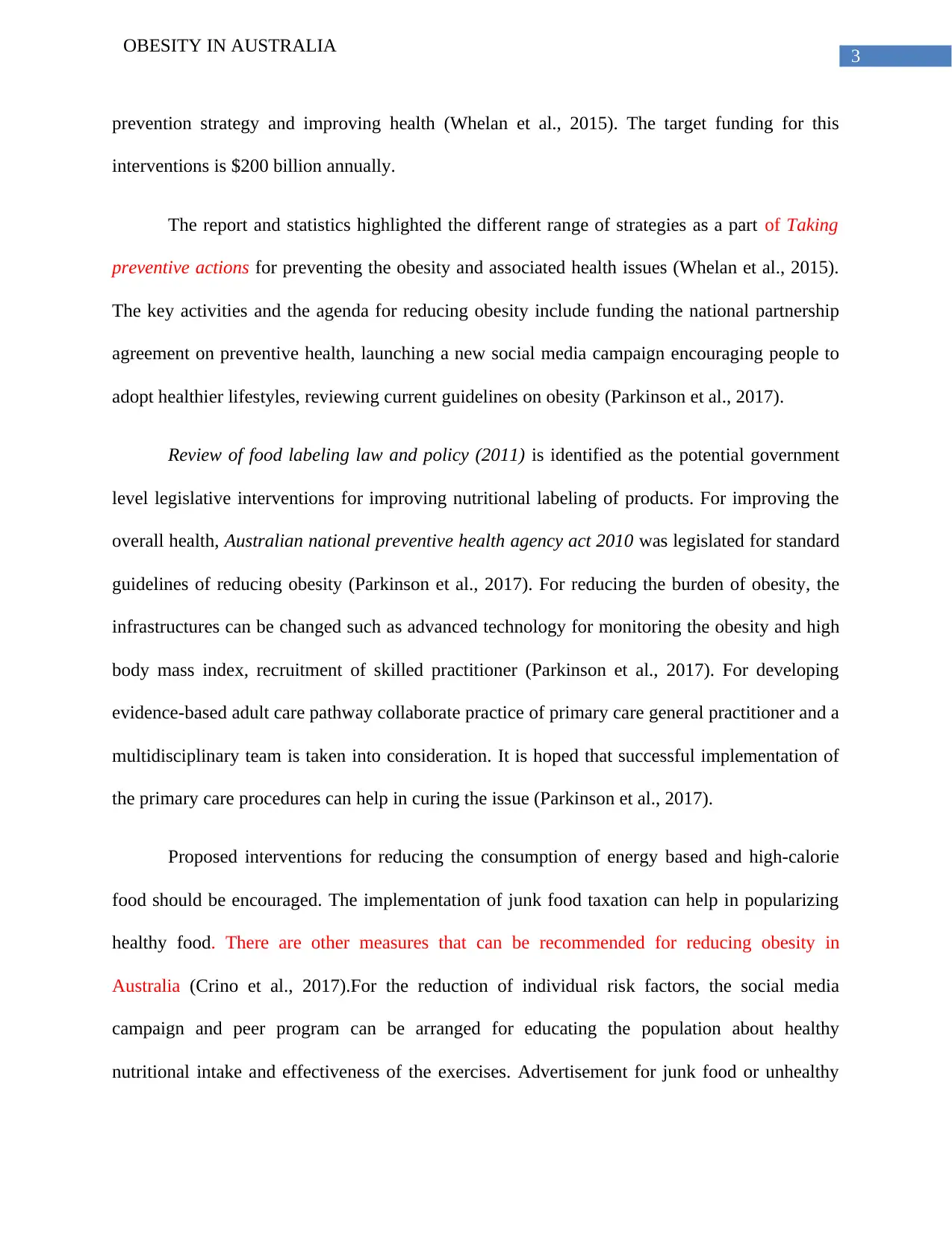
3
OBESITY IN AUSTRALIA
prevention strategy and improving health (Whelan et al., 2015). The target funding for this
interventions is $200 billion annually.
The report and statistics highlighted the different range of strategies as a part of Taking
preventive actions for preventing the obesity and associated health issues (Whelan et al., 2015).
The key activities and the agenda for reducing obesity include funding the national partnership
agreement on preventive health, launching a new social media campaign encouraging people to
adopt healthier lifestyles, reviewing current guidelines on obesity (Parkinson et al., 2017).
Review of food labeling law and policy (2011) is identified as the potential government
level legislative interventions for improving nutritional labeling of products. For improving the
overall health, Australian national preventive health agency act 2010 was legislated for standard
guidelines of reducing obesity (Parkinson et al., 2017). For reducing the burden of obesity, the
infrastructures can be changed such as advanced technology for monitoring the obesity and high
body mass index, recruitment of skilled practitioner (Parkinson et al., 2017). For developing
evidence-based adult care pathway collaborate practice of primary care general practitioner and a
multidisciplinary team is taken into consideration. It is hoped that successful implementation of
the primary care procedures can help in curing the issue (Parkinson et al., 2017).
Proposed interventions for reducing the consumption of energy based and high-calorie
food should be encouraged. The implementation of junk food taxation can help in popularizing
healthy food. There are other measures that can be recommended for reducing obesity in
Australia (Crino et al., 2017).For the reduction of individual risk factors, the social media
campaign and peer program can be arranged for educating the population about healthy
nutritional intake and effectiveness of the exercises. Advertisement for junk food or unhealthy
OBESITY IN AUSTRALIA
prevention strategy and improving health (Whelan et al., 2015). The target funding for this
interventions is $200 billion annually.
The report and statistics highlighted the different range of strategies as a part of Taking
preventive actions for preventing the obesity and associated health issues (Whelan et al., 2015).
The key activities and the agenda for reducing obesity include funding the national partnership
agreement on preventive health, launching a new social media campaign encouraging people to
adopt healthier lifestyles, reviewing current guidelines on obesity (Parkinson et al., 2017).
Review of food labeling law and policy (2011) is identified as the potential government
level legislative interventions for improving nutritional labeling of products. For improving the
overall health, Australian national preventive health agency act 2010 was legislated for standard
guidelines of reducing obesity (Parkinson et al., 2017). For reducing the burden of obesity, the
infrastructures can be changed such as advanced technology for monitoring the obesity and high
body mass index, recruitment of skilled practitioner (Parkinson et al., 2017). For developing
evidence-based adult care pathway collaborate practice of primary care general practitioner and a
multidisciplinary team is taken into consideration. It is hoped that successful implementation of
the primary care procedures can help in curing the issue (Parkinson et al., 2017).
Proposed interventions for reducing the consumption of energy based and high-calorie
food should be encouraged. The implementation of junk food taxation can help in popularizing
healthy food. There are other measures that can be recommended for reducing obesity in
Australia (Crino et al., 2017).For the reduction of individual risk factors, the social media
campaign and peer program can be arranged for educating the population about healthy
nutritional intake and effectiveness of the exercises. Advertisement for junk food or unhealthy
Paraphrase This Document
Need a fresh take? Get an instant paraphrase of this document with our AI Paraphraser
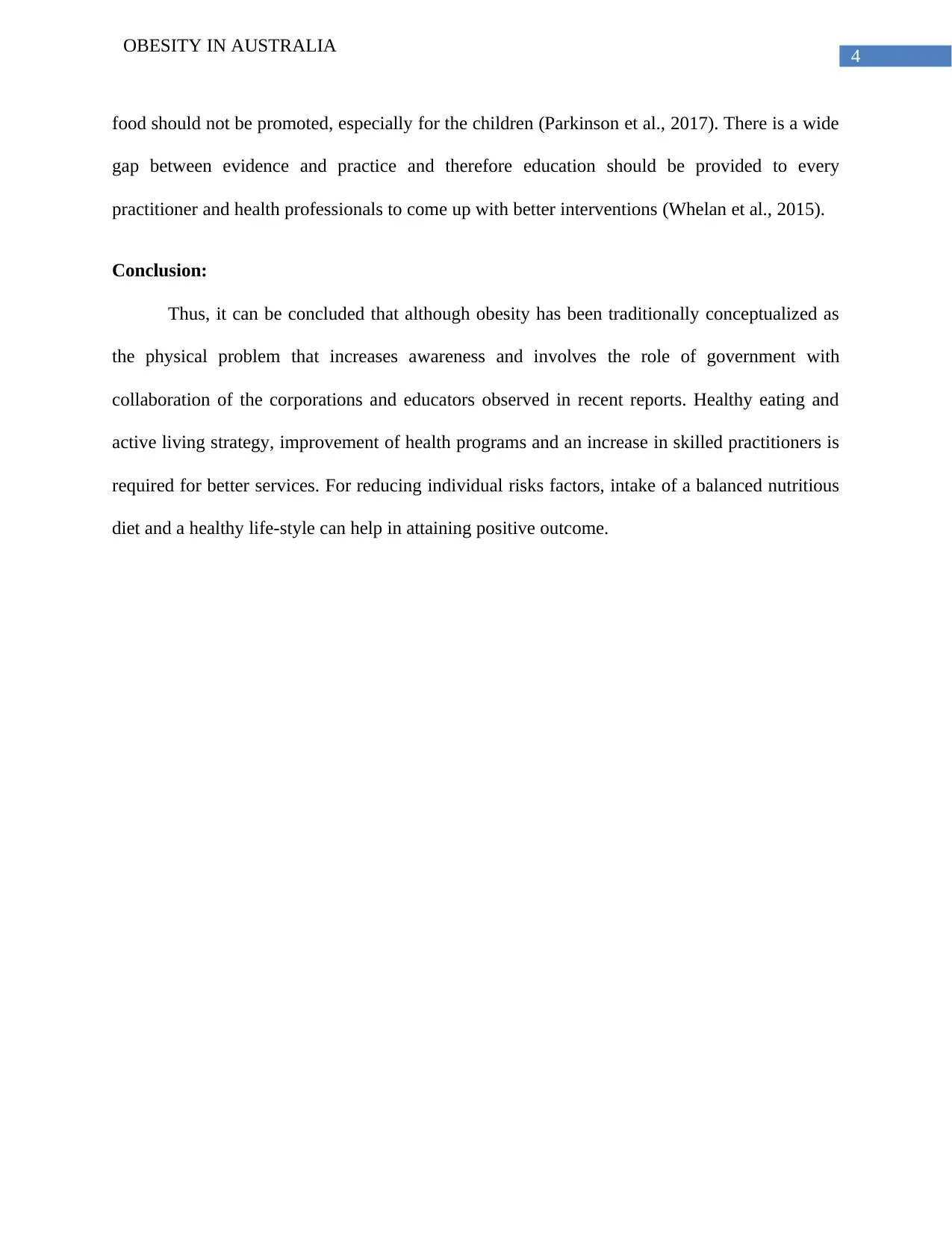
4
OBESITY IN AUSTRALIA
food should not be promoted, especially for the children (Parkinson et al., 2017). There is a wide
gap between evidence and practice and therefore education should be provided to every
practitioner and health professionals to come up with better interventions (Whelan et al., 2015).
Conclusion:
Thus, it can be concluded that although obesity has been traditionally conceptualized as
the physical problem that increases awareness and involves the role of government with
collaboration of the corporations and educators observed in recent reports. Healthy eating and
active living strategy, improvement of health programs and an increase in skilled practitioners is
required for better services. For reducing individual risks factors, intake of a balanced nutritious
diet and a healthy life-style can help in attaining positive outcome.
OBESITY IN AUSTRALIA
food should not be promoted, especially for the children (Parkinson et al., 2017). There is a wide
gap between evidence and practice and therefore education should be provided to every
practitioner and health professionals to come up with better interventions (Whelan et al., 2015).
Conclusion:
Thus, it can be concluded that although obesity has been traditionally conceptualized as
the physical problem that increases awareness and involves the role of government with
collaboration of the corporations and educators observed in recent reports. Healthy eating and
active living strategy, improvement of health programs and an increase in skilled practitioners is
required for better services. For reducing individual risks factors, intake of a balanced nutritious
diet and a healthy life-style can help in attaining positive outcome.
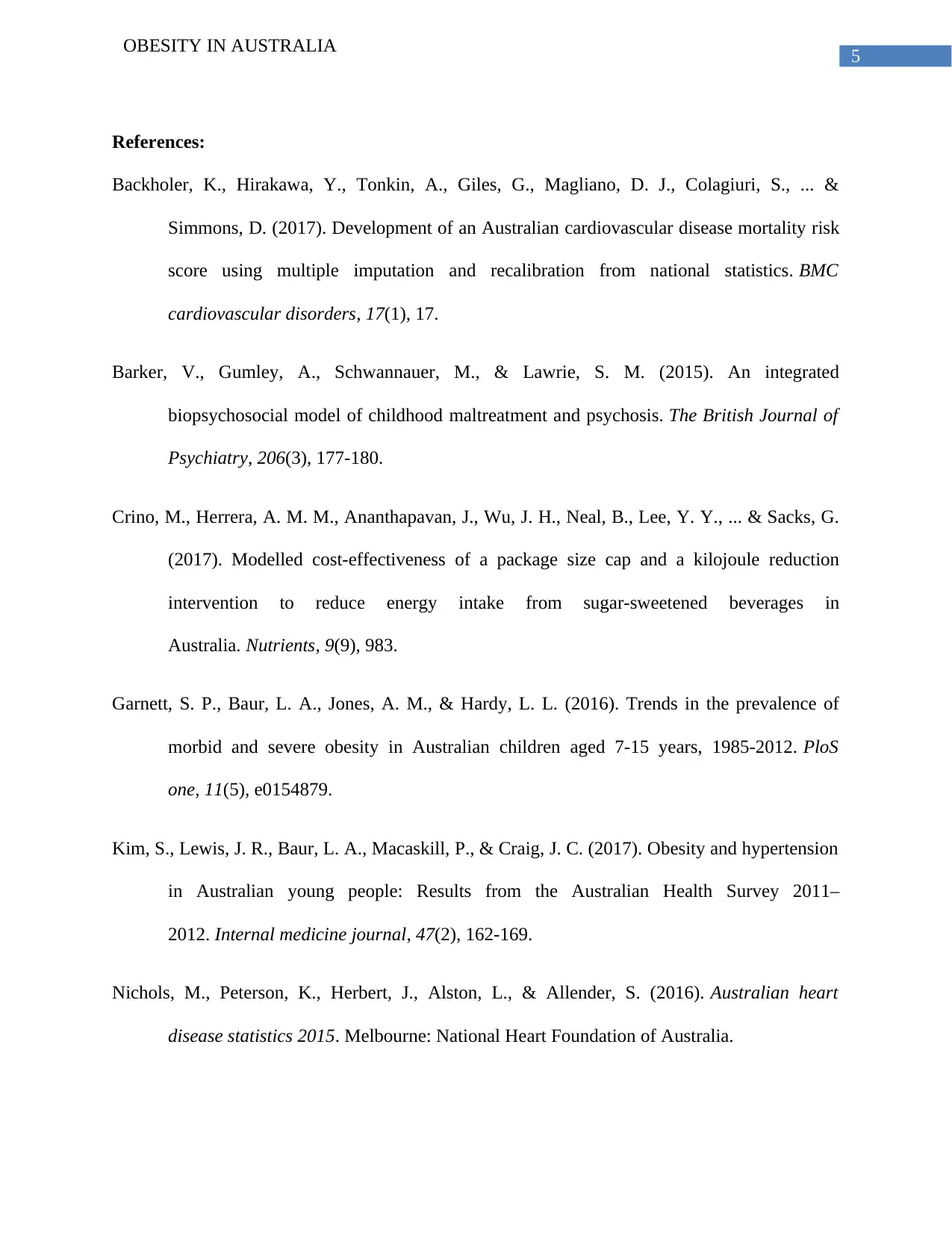
5
OBESITY IN AUSTRALIA
References:
Backholer, K., Hirakawa, Y., Tonkin, A., Giles, G., Magliano, D. J., Colagiuri, S., ... &
Simmons, D. (2017). Development of an Australian cardiovascular disease mortality risk
score using multiple imputation and recalibration from national statistics. BMC
cardiovascular disorders, 17(1), 17.
Barker, V., Gumley, A., Schwannauer, M., & Lawrie, S. M. (2015). An integrated
biopsychosocial model of childhood maltreatment and psychosis. The British Journal of
Psychiatry, 206(3), 177-180.
Crino, M., Herrera, A. M. M., Ananthapavan, J., Wu, J. H., Neal, B., Lee, Y. Y., ... & Sacks, G.
(2017). Modelled cost-effectiveness of a package size cap and a kilojoule reduction
intervention to reduce energy intake from sugar-sweetened beverages in
Australia. Nutrients, 9(9), 983.
Garnett, S. P., Baur, L. A., Jones, A. M., & Hardy, L. L. (2016). Trends in the prevalence of
morbid and severe obesity in Australian children aged 7-15 years, 1985-2012. PloS
one, 11(5), e0154879.
Kim, S., Lewis, J. R., Baur, L. A., Macaskill, P., & Craig, J. C. (2017). Obesity and hypertension
in Australian young people: Results from the Australian Health Survey 2011–
2012. Internal medicine journal, 47(2), 162-169.
Nichols, M., Peterson, K., Herbert, J., Alston, L., & Allender, S. (2016). Australian heart
disease statistics 2015. Melbourne: National Heart Foundation of Australia.
OBESITY IN AUSTRALIA
References:
Backholer, K., Hirakawa, Y., Tonkin, A., Giles, G., Magliano, D. J., Colagiuri, S., ... &
Simmons, D. (2017). Development of an Australian cardiovascular disease mortality risk
score using multiple imputation and recalibration from national statistics. BMC
cardiovascular disorders, 17(1), 17.
Barker, V., Gumley, A., Schwannauer, M., & Lawrie, S. M. (2015). An integrated
biopsychosocial model of childhood maltreatment and psychosis. The British Journal of
Psychiatry, 206(3), 177-180.
Crino, M., Herrera, A. M. M., Ananthapavan, J., Wu, J. H., Neal, B., Lee, Y. Y., ... & Sacks, G.
(2017). Modelled cost-effectiveness of a package size cap and a kilojoule reduction
intervention to reduce energy intake from sugar-sweetened beverages in
Australia. Nutrients, 9(9), 983.
Garnett, S. P., Baur, L. A., Jones, A. M., & Hardy, L. L. (2016). Trends in the prevalence of
morbid and severe obesity in Australian children aged 7-15 years, 1985-2012. PloS
one, 11(5), e0154879.
Kim, S., Lewis, J. R., Baur, L. A., Macaskill, P., & Craig, J. C. (2017). Obesity and hypertension
in Australian young people: Results from the Australian Health Survey 2011–
2012. Internal medicine journal, 47(2), 162-169.
Nichols, M., Peterson, K., Herbert, J., Alston, L., & Allender, S. (2016). Australian heart
disease statistics 2015. Melbourne: National Heart Foundation of Australia.
⊘ This is a preview!⊘
Do you want full access?
Subscribe today to unlock all pages.

Trusted by 1+ million students worldwide
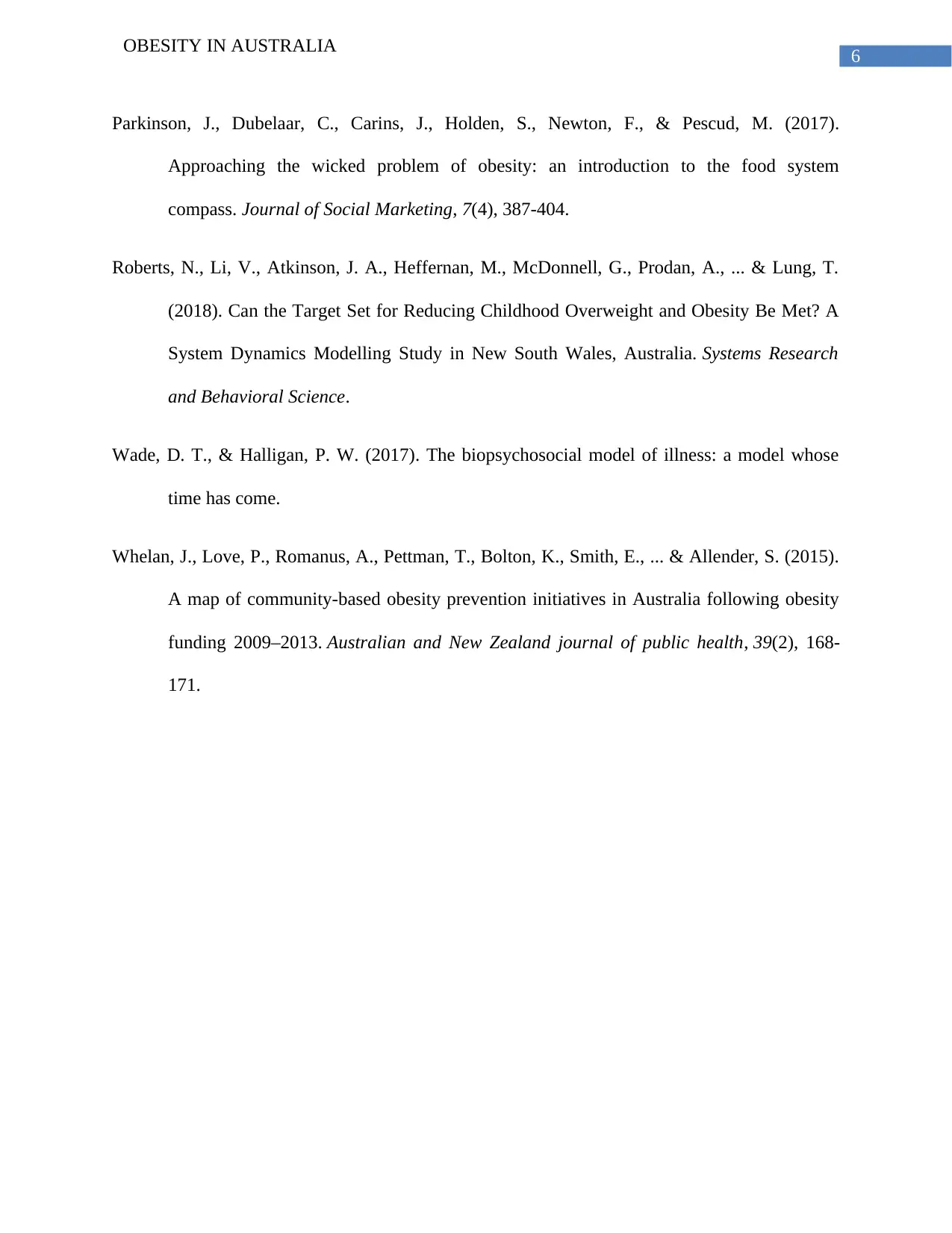
6
OBESITY IN AUSTRALIA
Parkinson, J., Dubelaar, C., Carins, J., Holden, S., Newton, F., & Pescud, M. (2017).
Approaching the wicked problem of obesity: an introduction to the food system
compass. Journal of Social Marketing, 7(4), 387-404.
Roberts, N., Li, V., Atkinson, J. A., Heffernan, M., McDonnell, G., Prodan, A., ... & Lung, T.
(2018). Can the Target Set for Reducing Childhood Overweight and Obesity Be Met? A
System Dynamics Modelling Study in New South Wales, Australia. Systems Research
and Behavioral Science.
Wade, D. T., & Halligan, P. W. (2017). The biopsychosocial model of illness: a model whose
time has come.
Whelan, J., Love, P., Romanus, A., Pettman, T., Bolton, K., Smith, E., ... & Allender, S. (2015).
A map of community‐based obesity prevention initiatives in Australia following obesity
funding 2009–2013. Australian and New Zealand journal of public health, 39(2), 168-
171.
OBESITY IN AUSTRALIA
Parkinson, J., Dubelaar, C., Carins, J., Holden, S., Newton, F., & Pescud, M. (2017).
Approaching the wicked problem of obesity: an introduction to the food system
compass. Journal of Social Marketing, 7(4), 387-404.
Roberts, N., Li, V., Atkinson, J. A., Heffernan, M., McDonnell, G., Prodan, A., ... & Lung, T.
(2018). Can the Target Set for Reducing Childhood Overweight and Obesity Be Met? A
System Dynamics Modelling Study in New South Wales, Australia. Systems Research
and Behavioral Science.
Wade, D. T., & Halligan, P. W. (2017). The biopsychosocial model of illness: a model whose
time has come.
Whelan, J., Love, P., Romanus, A., Pettman, T., Bolton, K., Smith, E., ... & Allender, S. (2015).
A map of community‐based obesity prevention initiatives in Australia following obesity
funding 2009–2013. Australian and New Zealand journal of public health, 39(2), 168-
171.
1 out of 7
Related Documents
Your All-in-One AI-Powered Toolkit for Academic Success.
+13062052269
info@desklib.com
Available 24*7 on WhatsApp / Email
![[object Object]](/_next/static/media/star-bottom.7253800d.svg)
Unlock your academic potential
Copyright © 2020–2025 A2Z Services. All Rights Reserved. Developed and managed by ZUCOL.





